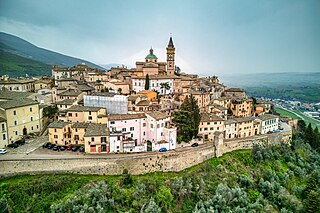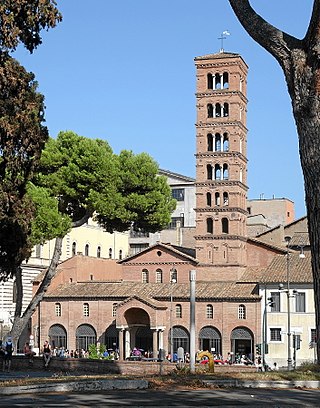
The Clitunno, in Antiquity the Clitumnus, is a river in Umbria, Italy. The name is of uncertain origin, but it was also borne by the river god. The Clitunno rises from a spring within a dozen metres of the ancient Via Flaminia near the town of Campello sul Clitunno between Spoleto and Trevi.

Spoleto is an ancient city in the Italian province of Perugia in east-central Umbria on a foothill of the Apennines. It is 20 km (12 mi) south of Trevi, 29 km (18 mi) north of Terni, 63 km (39 mi) southeast of Perugia; 212 km (132 mi) southeast of Florence; and 126 km (78 mi) north of Rome.

Todi is a town and comune (municipality) of the province of Perugia in central Italy. It is perched on a tall two-crested hill overlooking the east bank of the river Tiber, commanding distant views in every direction. It was founded in antiquity by the Umbri, at the border with Etruria; the gens Ulpia of Roman emperor Trajan came from Todi.

The Pantheon is a former Roman temple and, since AD 609, a Catholic church in Rome, Italy. It was built on the site of an earlier temple commissioned by Marcus Vipsanius Agrippa during the reign of Augustus ; then, after the original burnt down, the present building was ordered by the emperor Hadrian and probably dedicated c. AD 126. Its date of construction is uncertain, because Hadrian chose not to inscribe the new temple but rather to retain the inscription of Agrippa's older temple.

A rotunda is any roofed building with a circular ground plan, and sometimes covered by a dome. It may also refer to a round room within a building. The Pantheon in Rome is perhaps the most famous, and is the most influential rotunda. A band rotunda is a circular bandstand, usually with a dome.

Trevi is an ancient town and comune (municipality) in Umbria, Italy, on the lower flank of Mount Serano overlooking the wide plain of the Clitunno river system. Located in the Province of Perugia, it is 10 km (6 mi) SSE of Foligno and 20 km (12 mi) north of Spoleto. It is one of I Borghi più belli d'Italia.

San Pietro in Valle is a medieval abbey in the comune (township) of Ferentillo in Umbria.

Pigge or Lapigge is a village in the Italian province of Perugia in east central Umbria, stretching from the plain of the Clitunno river up the lower SW flank of Mt. Serano, at 297 m above sea-level. It is a frazione of the comune of Trevi, which is 3 km NNW. Its population was 463 in 2003.

Bettona is an ancient town and comune of Italy, in the province of Perugia in central Umbria at the northern edge of the Colli Martani range. It is 5 km (3 mi) E of Torgiano and 12 km (7 mi) SW of Assisi. It is one of I Borghi più belli d'Italia. Passaggio, Colle, and Cerreto are frazioni of the comune.

The Basilica of Saint Mary in Cosmedin is a minor basilican church in Rome, Italy, dedicated to the Virgin Mary. It is located in the rione (neighborhood) of Ripa. Constructed first in the sixth century as a diaconia (deaconry) in an area of the city populated by Greek immigrants, it celebrated Eastern rites and currently serves the Melkite Greek Catholic community of Rome. The church was expanded in the eighth century and renovated in the twelfth century, when a campanile was added. A Baroque facade and interior refurbishment of 1718 were removed in 1894–1899; the exterior was restored to twelfth-century form, while the architecture of the interior recalls the eighth century with twelfth-century furnishings. The narthex of the church contains the famous Bocca della Verità sculpture.

The Basilica of San Frediano is a Romanesque church in Lucca, Italy, situated on the Piazza San Frediano.

Spoleto Cathedral is the cathedral of the Archdiocese of Spoleto-Norcia created in 1821, previously that of the diocese of Spoleto, and the principal church of the Umbrian city of Spoleto, in Italy. It is dedicated to the Assumption of the Blessed Virgin Mary.

Villa Barbaro, also known as the Villa di Maser, is a large villa at Maser in the Veneto region of northern Italy. It was designed and built by the Italian Renaissance architect Andrea Palladio, with frescos by Paolo Veronese and sculptures by Alessandro Vittoria, for Daniele Barbaro, Patriarch of Aquileia and ambassador to Queen Elizabeth I of England and his brother Marcantonio, an ambassador to King Charles IX of France. The villa was added to the list of World Heritage Sites by UNESCO in 1996.

Castelseprio was the site of a Roman fort in antiquity, and a significant Lombard town in the early Middle Ages, before being destroyed and abandoned in 1287. It is today preserved as an archaeological park in the modern comune of Castelseprio, near the modern village of the same name. It is in the north of Italy, in the Province of Varese, about 50 km northwest of Milan.

San Salvatore is a former monastery in Brescia, Lombardy, northern Italy, now turned into a museum. The monastic complex is famous for the diversity of its architecture which includes Roman remains and significant pre-Romanesque, Romanesque and Renaissance buildings.

Longobards in Italy: Places of Power is seven groups of historic buildings that reflect the achievements of the Germanic tribe of the Lombards, who settled in Italy during the sixth century and established a Lombard Kingdom which ended in 774 A.D.

The Apse of Santa María d'Àneu is a romanesque apse of the church of Santa Maria, Àneu, created in the late 11th century or early 12th century, the transferred frescos from which are now exhibited at Museu Nacional d'Art de Catalunya, in Barcelona. The decoration of the apse of the church of Santa María d’Àneu combines themes and motifs from the Old and New Testaments. Originally painted at the Church of Santa María d’Àneu

Otranto Cathedral is a Roman Catholic cathedral in the Italian city of Otranto, dedicated to the Annunciation of the Virgin Mary. It is the archiepiscopal seat of the Archdiocese of Otranto. The cathedral was consecrated in 1088. It is 54 metres long by 25 metres wide and is built on 42 monolithic granite and marble columns from unknown quarries. Its plan is a three-aisled nave with an apsidal east end. On either side of the west façade are two lancet windows.

Saint George Greek Orthodox Cathedral is the seat of the Greek Orthodox Metropolitan bishop of the Greek Orthodox Archdiocese of Beirut and its dependencies. It is the city's oldest extant church: it has been built over the disappeared Anastasi Romano-Byzantine Cathedral.

The Oratorio di Santa Maria, or Oratory of Santa Maria, previously called the Tempietto longobardo, is located in Valle on the north-eastern frontier at Cividale del Friuli in the province of Udine. It was erected in the 8th century under the rule of a Germanic people called the Lombards who ruled most of the Italian Peninsula from 568 to 774. This is the most important and best preserved example of Lombard architecture, which resembles styles found in Ottonian, Roman, Lombardy and Carolingian art. Included within the temple and chapel are decorated frescoes and high relief sculptures of saints in stucco.




















